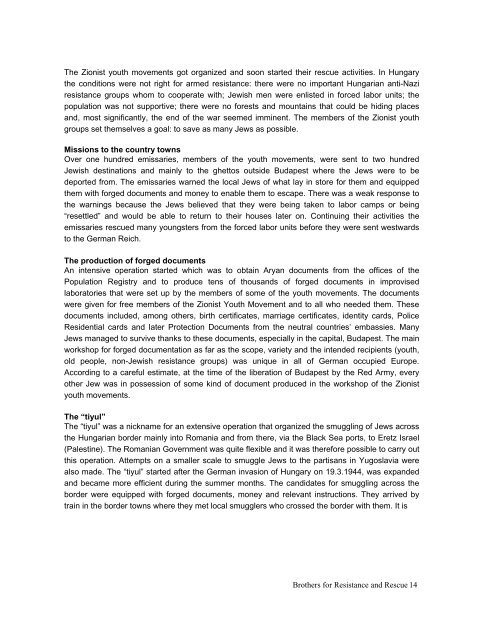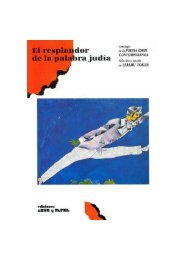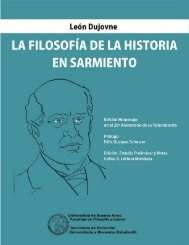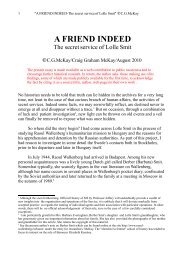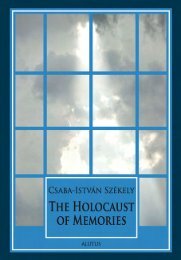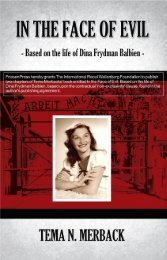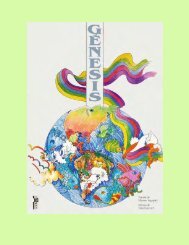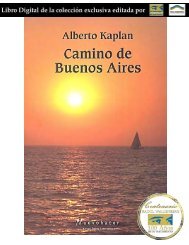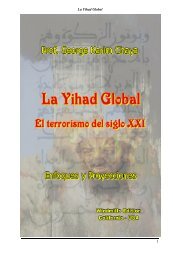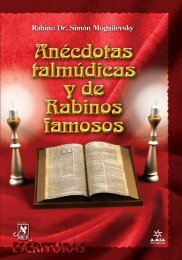- Page 1 and 2: Brothers for Resistance and Rescue
- Page 3 and 4: Copyright © The Society for the Re
- Page 5 and 6: ContentsINTRODUCTION ..............
- Page 7 and 8: several neutral countries, especial
- Page 9 and 10: I wish to express my special thanks
- Page 11 and 12: Herzl himself visited Hungary a few
- Page 13: THE UNDERGROUND ZIONIST YOUTH MOVEM
- Page 17 and 18: LIST OF ZIONIST YOUTH MOVEMENTSAND
- Page 19 and 20: Hatzioni” movement, which at the
- Page 21 and 22: CommunistsThe Hungarian communists
- Page 23 and 24: of Tony, who had a Jewish girlfrien
- Page 25 and 26: The two were about to leave the hou
- Page 27 and 28: preparation for aliya was given to
- Page 29 and 30: was told. “We contacted everyone
- Page 31 and 32: Adler MordehaiAdler GyörgyBorn in
- Page 33 and 34: Agmon Efraim (Efra)Teichman ErnőBo
- Page 35 and 36: In the winter of 1944-1945 she was
- Page 37 and 38: Alpan TovaDiamant GertrudeBorn on 4
- Page 39 and 40: Amir MiriamSpinner Mária “Marcsa
- Page 41 and 42: Arbel Yitzhak 'Bukszi'Baumöhl Istv
- Page 43 and 44: Asael TzviAuslaender Herman ‘Nagy
- Page 45 and 46: Garany detention camp, 1943.Members
- Page 47 and 48: Avidor YardenaPolák GizellaBorn in
- Page 49 and 50: for refugees in one of the capital
- Page 51 and 52: law. When the truth emerged, the Ge
- Page 53 and 54: In the summer of 1943 Joseph contac
- Page 55 and 56: he met Rafi Benshalom, who enlisted
- Page 57 and 58: The Hungarian translation published
- Page 59 and 60: helped free Jews from forced labor
- Page 61 and 62: August 1944 he tried to cross the b
- Page 63 and 64: Adonyahu traveled to Debrecen again
- Page 65 and 66:
of Jewish refugees over the border
- Page 67 and 68:
when it became part of the “World
- Page 69 and 70:
Braun YitzhakBraun FerencBorn in So
- Page 71 and 72:
After the war he made aliya. He liv
- Page 73 and 74:
the fascist police. He was sentence
- Page 75 and 76:
November 1944 Amir organized a refu
- Page 77 and 78:
uilt a stock of military equipment,
- Page 79 and 80:
(Palestine) and joined the hahshara
- Page 81 and 82:
families who managed to escape from
- Page 83 and 84:
Members of "Bnei Akiva", 1943.From
- Page 85 and 86:
Fast ShmuelFast MiklósBorn in Eper
- Page 87 and 88:
activities of the movement. At the
- Page 89 and 90:
Fleischer GyörgyMember of the “S
- Page 91 and 92:
his wife, Malka Baumøhl. In Kassa
- Page 93 and 94:
Fraenkel AvrahamSamuel BenjaminFrae
- Page 95 and 96:
Fraenkel MordehaiFraenkel MiklósBo
- Page 97 and 98:
Freiman TzviFreiman TamásBorn in K
- Page 99 and 100:
movement and with the aliya of youn
- Page 101 and 102:
immigrants from the ships to the sh
- Page 103 and 104:
Dr. Galor EliyahuDr. Gellért Endre
- Page 105 and 106:
Bader. Her name was given because d
- Page 107 and 108:
of the tiyul but instead, in June 1
- Page 109 and 110:
Goldberger YaakovGoldberger OttóBo
- Page 111 and 112:
daring operation of members of the
- Page 113 and 114:
Goldstein ShoshannaRoth ÁgnesBorn
- Page 115 and 116:
Grossman AlexanderSándor 'Sanyi'Bo
- Page 117 and 118:
"Habonim" outing, 1943. Joseph Gár
- Page 119 and 120:
Grosz YitzhakGrosz ErnőBorn in Deb
- Page 121 and 122:
Grünwald David 'Coca'Grünwald Bé
- Page 123 and 124:
an office for the management of eng
- Page 125 and 126:
Members of "Dror", outing in the hi
- Page 127 and 128:
On October 31 st his camp was attac
- Page 129 and 130:
papers. Hadasa stayed in the town o
- Page 131 and 132:
Heffner DéziHeffner-Reiner DéziBo
- Page 133 and 134:
Herman ShlomoHerman Slomo LadislavB
- Page 135 and 136:
Hőnig Braha 'Bruhi'Hőnig Borbála
- Page 137 and 138:
Izsák HavaIzsák ÉvaBorn in Szatm
- Page 139 and 140:
Prof. Kadari Menahem TzviSchwarcz E
- Page 141 and 142:
Kama YirmiyahuKemény JackieBorn in
- Page 143 and 144:
unker has been discovered, and Avra
- Page 145 and 146:
Katz ImreBorn in Nyiregyháza on 17
- Page 147 and 148:
"Hanoar Hatzioni" at the Balatonbog
- Page 149 and 150:
Kilon MosheKlein TiborBorn in Budap
- Page 151 and 152:
Klein JoliMansworth JoliMember of
- Page 153 and 154:
Knapp MenahemKnapp BélaBorn in Ér
- Page 155 and 156:
and through this organization expan
- Page 157 and 158:
Krausz MosheKrausz MiklósBorn in M
- Page 159 and 160:
Langer Miklós 'Miki'Born in Poprad
- Page 161 and 162:
uniform, he took Jewish families fr
- Page 163 and 164:
Members of "Dror Habonim" ("Hehalut
- Page 165 and 166:
Levavi DinaKomlós KarolinaBorn in
- Page 167 and 168:
Levi SimonLöwi SimonBorn in 1926Pe
- Page 169 and 170:
Lisszauer AvriLisszauer ZoltánBorn
- Page 171 and 172:
Cross patrols and giving assistance
- Page 173 and 174:
Margalit JosephMarkstein JózsefBor
- Page 175 and 176:
opened a new channel of cooperation
- Page 177 and 178:
Minervi HannaWertheimer EditBorn in
- Page 179 and 180:
on missions to the country towns ca
- Page 181 and 182:
comrade who came to the camp where
- Page 183 and 184:
Offner Róbert 'Fifi'Born in Kassa
- Page 185 and 186:
Palgi JoelNussbecher EmilBorn in Ko
- Page 187 and 188:
Cross and was sent to the children
- Page 189 and 190:
Prizant TzviPrizant HermanBorn in T
- Page 191 and 192:
Reichman EzraReichman ErnőBorn in
- Page 193 and 194:
forged papers from underground acti
- Page 195 and 196:
Révész YirmiyahuRévész IstvánB
- Page 197 and 198:
Rip ImreBorn in Újvidék (Novi Sad
- Page 199 and 200:
Ronel Aliza 'Lulu'Barmat AlizaBorn
- Page 201 and 202:
Ya’akov participated in the Inter
- Page 203 and 204:
Rosenberg MosheBorn in Csenger on 2
- Page 205 and 206:
In May 1944 Yeshayahu enlisted in a
- Page 207 and 208:
Dr. Roth StephenDr. Roth Sigfried Z
- Page 209 and 210:
Sadeh ShlomoSzabó TamásBorn in Bu
- Page 211 and 212:
Salomon HavaBarmat ÉvaBorn in Érs
- Page 213 and 214:
Schechter DavidBorn in Técső (Tya
- Page 215 and 216:
Schlesinger Yaffe GabrielBorn in 18
- Page 217 and 218:
Schwartz ShayeSchwartz FrigyesBorn
- Page 219 and 220:
Shaanan HaimStern HeniBorn in Érse
- Page 221 and 222:
Shapira MosheShapira MórBorn in Ny
- Page 223 and 224:
units where foreigners served. In t
- Page 225 and 226:
Somló LászlóSpitzer LászlóBorn
- Page 227 and 228:
Spitzer LeaNeuwirth EditBorn in Nag
- Page 229 and 230:
away from the camp and, together wi
- Page 231 and 232:
he was incarcerated in the prisoner
- Page 233 and 234:
front. He was arrested in his apart
- Page 235 and 236:
Szántó ShmuelSzántó Andor Mikl
- Page 237 and 238:
Szenes HannaSzenes AnikóBorn in Bu
- Page 239 and 240:
Tordai Sándor Dr.Tischler Sándor
- Page 241 and 242:
Tzahor MiriamWeisz Eisenberg Mirjam
- Page 243 and 244:
Vardi EstherSechter EditBorn in Té
- Page 245 and 246:
Weil ShragaWeil Ferenc FerdinándBo
- Page 247 and 248:
Weisz EliezerWeisz LászlóBorn in
- Page 249 and 250:
Weisz MosheBorn in Munkács (Mukacs
- Page 251 and 252:
hurt in her neck by a sharp block o
- Page 253 and 254:
Weisz Yirmiyahu 'Yirmi'Born in Tót
- Page 255 and 256:
Wiesel HaimWiesel BernátBorn in Sa
- Page 257 and 258:
Dr. Yakobi MenahemJakubovics EmilBo
- Page 259 and 260:
Zohar KálmánSonnenschein Kálmán
- Page 261 and 262:
EPILOGUEThis book is dedicated to t
- Page 263 and 264:
Hahshara: Hebrew for training & pre
- Page 265 and 266:
BIBLIOGRAPHY1) A Hasomér Hacair a
- Page 267 and 268:
32. Chava Eichler & Yehuda Talmi, H
- Page 269 and 270:
Index of NamesAdler Betzalel ......
- Page 271 and 272:
Grünwald David 'Coca'.............
- Page 273 and 274:
Sajó Eli .........................


